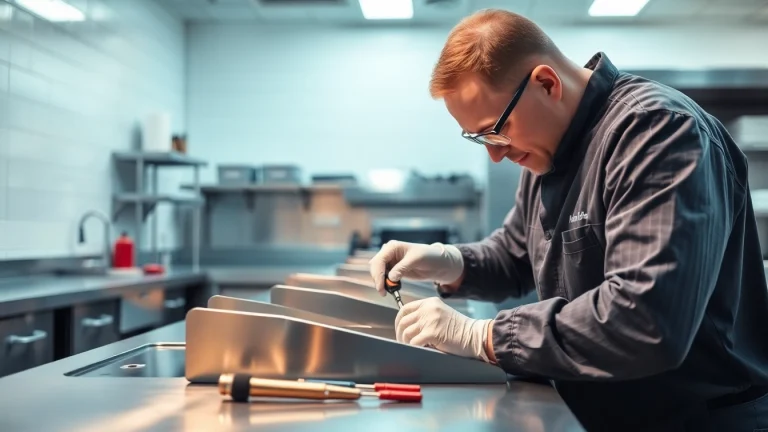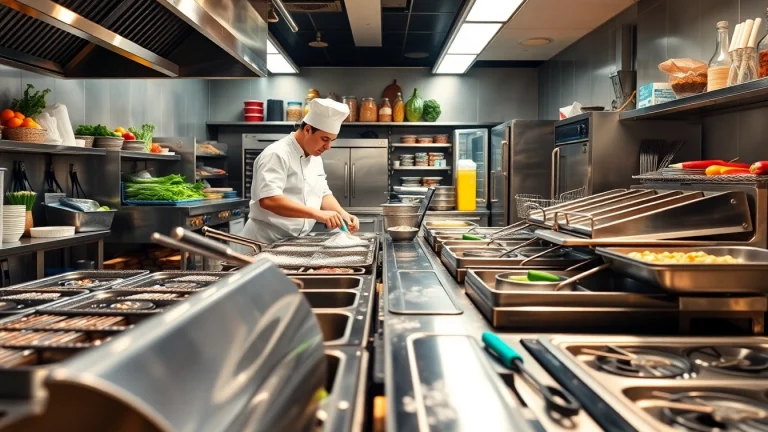
Comprehensive Guide to Prep Table Repair: Common Issues and Solutions
Understanding Prep Table Repair
In the world of commercial kitchens, efficiency and reliability are paramount. One of the essential pieces of equipment that helps achieve this is the prep table. Whether it’s a refrigerated pizza prep table or a standard workstation for salad preparation, these tables are critical in a busy kitchen environment. Given their importance, understanding how to maintain and repair these tables is essential for chefs and kitchen managers alike. This comprehensive guide on prep table repair breaks down the types of tables, common issues encountered, maintenance practices, and more.
What is a Prep Table?
A prep table is a specialized piece of kitchen equipment designed to provide chefs a designated area for food preparation. These tables are often equipped with under-counter refrigeration to keep ingredients fresh and are essential for maintaining food safety standards. They come in various forms, including pizza prep tables, salad prep tables, and sandwich prep tables, tailored to different cooking needs.
Common Reasons for Prep Table Failures
Despite their reliability, prep tables can encounter several issues over time. Some of the most common reasons for failure include:
- Mechanical Failures: Components like compressors, condensers, and thermostats can malfunction due to wear and tear.
- Poor Maintenance: Neglecting regular cleaning and maintenance can lead to build-up and inefficiency.
- Environmental Factors: Extreme temperature swings or humidity can impact the functionality of the unit.
Importance of Regular Maintenance
Regular maintenance is crucial not only for the longevity of prep tables but also for ensuring food safety and kitchen efficiency. A well-maintained prep table can reduce energy costs, minimize the risk of foodborne illnesses, and enhance the overall kitchen workflow.
Identifying Common Prep Table Problems
When a prep table malfunctions, identifying the problem quickly can save time and resources. Below are some common issues and their corresponding indicators.
Thermostat Failures and Fixes
One of the most frequent malfunctions in refrigeration units is thermostat failure. Symptoms of malfunction can include:
- Inconsistent temperatures inside the unit.
- Cooling cycles that are too long or too short.
- Visible ice build-up in the unit.
To fix this, the thermostat may need recalibration or replacement, depending on the severity of the failure.
Poor Door Seals and Their Impact
Poorly sealing doors can lead to temperature inconsistencies and energy inefficiencies. Signs of a failing door seal include:
- Frost accumulation around the door edges.
- Condensation on the outside of the table.
- Increased compressor activity, leading to potential burnout.
Replacing damaged seals can often remedy these issues.
Handling Temperature Issues
If food products are not maintaining safe temperatures, immediate action is required. Routine checks with calibrated thermometers should be implemented to monitor the temperatures inside the prep table.
Steps for Effective Prep Table Repair
When it comes to repairing a prep table, following a systematic approach is essential for success. The steps can be broken down as follows:
Initial Assessment and Troubleshooting
Before any repairs, it’s crucial to make an initial assessment of the symptoms. Check for visible signs of damage, unusual noises, or temperature irregularities. Record these observations, as they will help during the repair process.
Disassembly and Component Check
Once a problem has been identified, disassemble the necessary components of the prep table to expose internal parts. Common areas to inspect include:
- The compressor.
- Electrical connections.
- The refrigeration coil.
This process should be done cautiously, ensuring all power sources are disconnected to prevent accidents.
Reassembly and Testing Procedures
After the necessary repairs and replacements have been made, reassemble the prep table, ensuring all components fit snugly and securely. Once reassembled, power the unit back on and perform a series of tests:
- Monitor temperature levels for consistency.
- Check for any unusual noises or vibrations.
- Ensure door seals are intact and functioning properly.
Maintenance Tips to Prevent Future Issues
Preventive maintenance can significantly reduce the likelihood of future issues. The following tips can help keep prep tables in optimal condition.
Regular Cleaning and Sanitization
Routine cleaning is vital for maintaining food safety and the longevity of prep tables. Establishing a daily cleaning schedule involving:
- Removing all food debris.
- Using appropriate sanitizers on surfaces.
- Regularly wiping down external and internal components.
Storage and Usage Best Practices
Proper usage and storage practices can greatly extend the life of a prep table. Key practices include:
- Avoid overloading the table with too many items.
- Store items at recommended temperatures to avoid overworking the compressor.
- Keep heavy items away from the door to avoid strain on hinges.
Schedule for Routine Maintenance
Engaging in routine checks and balances can help prevent future problems. A good practice is to schedule quarterly maintenance evaluations by professional technicians to ensure all components are functioning optimally.
When to Call a Professional for Prep Table Repair
While many repairs can be handled in-house, certain situations necessitate specialized expertise. Recognizing when to call a professional is essential.
Signs You Need Expert Help
If you notice persistent issues despite your maintenance efforts, it may be time to consult with an expert. Indicators that professional intervention is needed include:
- Frequent compressor cycling or loud noises.
- Significant build-up of frost or ice.
- Continuous temperature fluctuations.
Cost Considerations for Repairs
The cost for prep table repairs can vary widely based on the severity of the issue and the type of repair required. On average, minor repairs can cost between $100 to $300, while more extensive mechanical issues may exceed $500.
Choosing the Right Repair Service
When selecting a repair service for a prep table, consider factors such as experience, customer reviews, and guarantee of work. Opt for professionals who specialize in commercial kitchen equipment and have a proven track record.
Conclusion
Understanding the nuances of prep table repair and maintenance is essential for any professional kitchen. By recognizing common issues, implementing proper maintenance practices, and knowing when to call for professional help, kitchen managers can ensure their prep tables remain functional, efficient, and compliant with food safety standards. This approach not only serves to extend the life of the equipment but also promotes a smoother kitchen operation, ultimately enhancing service quality and customer satisfaction.


